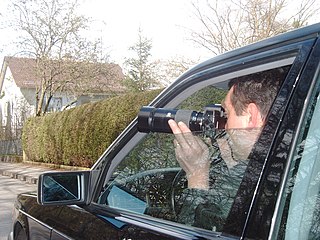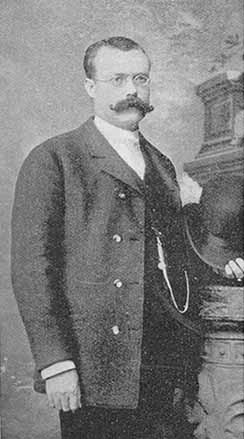Related Research Articles

Allan J. Pinkerton was a Scottish-American cooper, abolitionist, detective, and spy, best known for creating the Pinkerton National Detective Agency in the United States and his claim to have foiled a plot in 1861 to assassinate president-elect Abraham Lincoln. During the Civil War, he provided the Union Army – specifically General George B. McClellan of the Army of the Potomac – with military intelligence, including extremely inaccurate enemy troop strength numbers. After the war, his agents played a significant role as strikebreakers – in particular during the Great Railroad Strike of 1877 – a role that Pinkerton men would continue to play after the death of their founder.

A private investigator, a private detective, or inquiry agent is a person who can be hired by individuals or groups to undertake investigatory law services. Private investigators often work for attorneys in civil and criminal cases.

Pinkerton is a private security guard and detective agency established around 1850 in the United States by Scottish-born American cooper Allan Pinkerton and Chicago attorney Edward Rucker as the North-Western Police Agency, which later became Pinkerton & Co, and finally the Pinkerton National Detective Agency. It is currently a subsidiary of Swedish-based Securitas AB.
Pinkerton may refer to:
Railroad police or railway police are people responsible for the protection of railroad properties, facilities, revenue, equipment, and personnel, as well as carried passengers and cargo. Railroad police may also patrol public rail transit systems. Their exact roles differs from country to country. In some countries, railroad police are no different from any other police agency, while in others they are more like security police. Some are given extensive additional authority, while those in other jurisdictions are more restricted.

The Molly Maguires were an Irish 19th-century secret society active in Ireland, Liverpool and parts of the Eastern United States, best known for their activism among Irish-American and Irish immigrant coal miners in Pennsylvania. After a series of often violent conflicts, twenty suspected members of the Molly Maguires were convicted of murder and other crimes and were executed by hanging in 1877 and 1878. This history remains part of local Pennsylvania lore and the actual facts are much debated among historians.
The Baldwin–Felts Detective Agency was a private detective agency in the United States from the early 1890s to 1937. Members of the agency were central actors in the events that led to the Battle of Blair Mountain in 1921 and violent repression of labor union members as part of the Coal Wars in such places as the Pocahontas Coalfield region of West Virginia, the Paint Creek–Cabin Creek strike of 1912 in West Virginia, 1913–1914 Colorado Coalfield War, and the Battle of Matewan in 1920.
In the United States Senate, the La Follette Civil Liberties Committee, or more formally, Committee on Education and Labor, Subcommittee Investigating Violations of Free Speech and the Rights of Labor (1936–1941), began as an inquiry into a National Labor Relations Board (NLRB) investigation of methods used by employers in certain industries to avoid collective bargaining with unions.
There were two related incidents between miners and mine owners in the Coeur d'Alene Mining District of North Idaho: the Coeur d'Alene, Idaho labor strike of 1892, and the Coeur d'Alene, Idaho labor confrontation of 1899. This article is a brief overview of both events.

James McParland was an American private detective and Pinkerton agent.
Morris Friedman was, until 1905, the private stenographer for Pinkerton detective James McParland. Friedman came to the attention of the public when he published an exposé of anti-union actions by the private detective industry which was called The Pinkerton Labor Spy. The book focused in particular on how mining and ore milling companies used spies during the Colorado Labor Wars.

The Colorado Labor Wars were a series of labor strikes in 1903 and 1904 in the U.S. state of Colorado, by gold and silver miners and mill workers represented by the Western Federation of Miners (WFM). Opposing the WFM were associations of mine owners and businessmen at each location, supported by the Colorado state government. The strikes were notable and controversial for the accompanying violence, and the imposition of martial law by the Colorado National Guard in order to put down the strikes.
Labor spying in the United States had involved people recruited or employed for the purpose of gathering intelligence, committing sabotage, sowing dissent, or engaging in other similar activities, in the context of an employer/labor organization relationship. Spying by companies on union activities has been illegal in the United States since the National Labor Relations Act of 1935. However, non-union monitoring of employee activities while at work is perfectly legal and, according to the American Management Association, nearly 80% of major US companies actively monitor their employees.

Kate Warne was an American law enforcement officer known as the first female detective, in 1856, in the Pinkerton Detective Agency and the United States.

The history of union busting in the United States dates back to the Industrial Revolution in the 19th century. The Industrial Revolution produced a rapid expansion in factories and manufacturing capabilities. As workers moved from farms to factories, mines and other hard labor, they faced harsh working conditions such as long hours, low pay and health risks. Children and women worked in factories and generally received lower pay than men. The government did little to limit these conditions. Labor movements in the industrialized world developed and lobbied for better rights and safer conditions. Shaped by wars, depressions, government policies, judicial rulings, and global competition, the early years of the battleground between unions and management were adversarial and often identified with aggressive hostility. Contemporary opposition to trade unions known as union busting started in the 1940s, and continues to present challenges to the labor movement. Union busting is a term used by labor organizations and trade unions to describe the activities that may be undertaken by employers, their proxies, workers and in certain instances states and governments usually triggered by events such as picketing, card check, worker organizing, and strike actions. Labor legislation has changed the nature of union busting, as well as the organizing tactics that labor organizations commonly use.

The 1892 Coeur d'Alene labor strike erupted in violence when labor union miners discovered they had been infiltrated by a Pinkerton agent who had routinely provided union information to the mine owners. The response to the labor violence, disastrous for the local miners' union, became the primary motivation for the formation of the Western Federation of Miners (WFM) the following year. The incident marked the first violent confrontation between the workers of the mines and their owners. Labor unrest continued after the 1892 strike, and surfaced again in the labor confrontation of 1899.
The Pinkerton Labor Spy is a nonfiction book published in 1907 as an exposé of intrigue and abuses by the Pinkerton Detective Agency in general, and by chief agent James McParland in particular.

Anti-union violence is physical force intended to harm union officials, union organizers, union members, union sympathizers, or their families. It is most commonly used either during union organizing efforts, or during strikes. The aim most often is to prevent a union from forming, to destroy an existing union, or to reduce the effectiveness of a union or a particular strike action. If strikers prevent people or goods to enter or leave a workplace, violence may be used to allow people and goods to pass the picket line.

The William J. Burns International Detective Agency was a private detective agency in the United States, which was operated by William J. Burns. Founded in 1909, the agency had evolved into Burns Security then Burns International by August 2000, when it was acquired by Securitas AB. From 1969 to 1983 it was headquartered in Briarcliff Manor, New York.

Anti-union violence in the United States is physical force intended to harm union officials, union organizers, union members, union sympathizers, or their families. It has most commonly been used either during union organizing efforts, or during strikes. The aim most often is to prevent a union from forming, to destroy an existing union, or to reduce the effectiveness of a union or a particular strike action. If strikers prevent people or goods to enter or leave a workplace, violence may be used to allow people and goods to pass the picket line.
References
- Dorich, Thomas J. "This Is a Tough Place to Work: Industrial Relations in the Jerome Mines, 1900–1922." Journal of Arizona History. 38 (Autumn 1997).
- Morn, Frank. The Eye That Never Sleeps: A History of the Pinkerton National Detective Agency. Bloomington: Indiana University Press, 1982. ISBN 0253320860
- Weiss, Robert P. "Private Detective Agencies and Labour Discipline in the United States, 1855–1946." Historical Journal. 29:1 (March 1986).